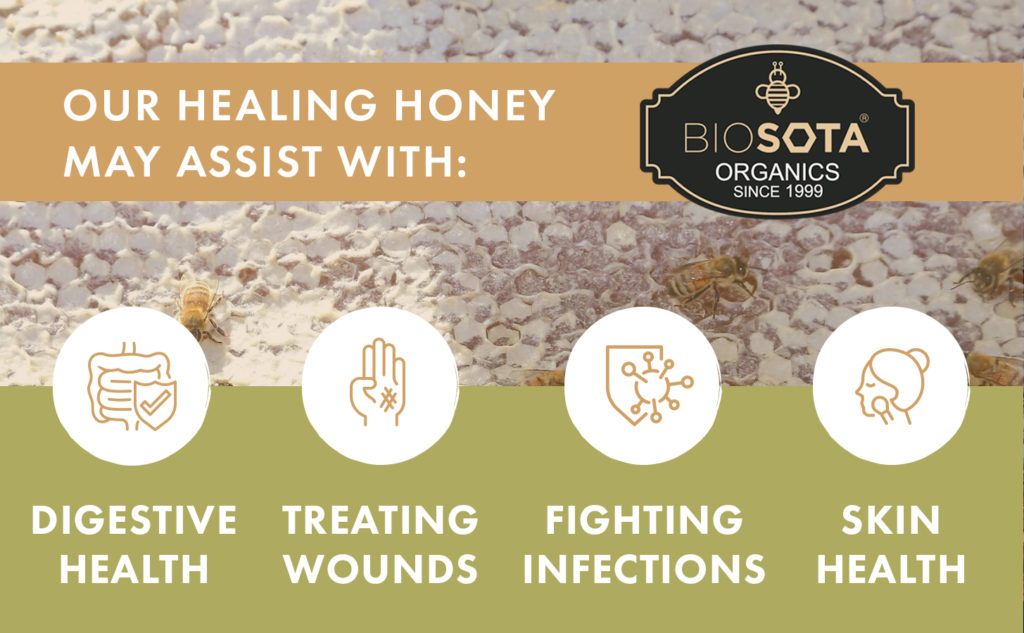The Ultimate Guide to Manuka Honey

Manuka Honey
Buying great honey doesn’t need to be confusing, so we have created this The Ultimate Guide to Manuka Honey. We break down everything from the Science to the Trademark Rivalry. We are sure that by the end of this Article you will understand Manuka Honey and its Medicinal Qualities.
Manuka Honey has antimicrobial properties, making it antibacterial, antifungal and antiviral as well as having anti-inflammatory, antioxidant and immune-modulatory properties. These properties make the honey great for digestion, immune function and skin-care. Manuka honey contains over 2,000 individual natural compounds, which is 20 times more than some conventional honeys.
History:
Manuka honey is the product of the nectar collected from Leptospermum scoparium. The Maori first called it ‘Manuka’. In 1922 in the government publication ‘Honey Flora of Victoria’ of 1922 it was described as “The Manuka”. In NSW and QLD it was known as “jellybush”, and in parts of Victoria it was called “goo-bush”. It was in the 1990s that New Zealand scientist Peter Molan identified its antibacterial properties which distinguished it from other honey, making it particularly useful for wound dressing.
Before the antibacterial properties were discovered, the honey was often disregarded by keepers and consumers alike for its gluey consistency that would clog the beekeeper’s hives. It was so strongly flavoured that consumers were interested in its unique flavour, so they didn’t want to buy it. Funny how things change! Manuka honey has become a global phenomenon. In China, it can fetch up to $400 a kilogram. Novak Djokovic the tennis champion eats two spoonful’s every day and actress Gwyneth Paltrow adds it to her smoothies. It is projected that the market will be worth 1.2 billion by 2028. What a remarkable ascent it been for a honey that beekeepers once struggled to give away for free. For this we can thank the efforts of the New Zealand Honey industry.
It was good old Kiwi science that first recognised its antibacterial properties and the New Zealand honey industry that identified a market and invested in research and development for the product. As a result Australian beekeepers gradually became aware of the goldmine in the bush, the New Zealand honey industry became increasingly litigious to keep the barbarians from the gate. In New Zealand, there is a group called the Manuka Honey Appellation Society. They are seeking to prevent Australian beekeepers from using the term ‘manuka honey’ in various jurisdictions around the world. If they are successful, Australia’s fledging manuka industry will be flattened. Some good news is that Australia is home to 84 of the 87 known Leptospermum species worldwide, including the Leptospermum scoparium species.
New Zealand and Australian Manuka Honey
Both Australia and New Zealand produce Manuka honey. Whilst the two countries dispute over who can officially call it Manuka honey but infact this is more of a copy right claim as they both boast the high levels of MGO sought after in Manuka Honey. In New Zealand, to be able to call the product manuka honey, it can only be derived from the Leptospermum scoparium. In Australia, it is derived from multiple species of the Leptospermum plant as the plants often grow side by side. So the difference stems from the plants the honey is made. The Australian Manuka honey is slightly darker than New Zealand. Both have high antibacterial properties. It seems like the biggest problem is that New Zealand would like to have sole rights to sell the product in China, where a single bottle can be sold for many hundreds of dollars.
Australian Manuka-style honey is at least as medically powerful as New Zealand Manuka honey, a study has found. A study at the University of Technology, Sydney showed that 16 per cent of Australian manuka style honey were more potent than the kiwi product. A great win for Australian Manuka.
Dr Cokcetin who was a lead author of the study said “One of the really special things about manuka honey is that it kills superbugs like golden staph and the most exciting thing about this research is that it puts Australian manuka honey on the international radar. Lots of people have heard of New Zealand manuka, but not many are aware that we have more than 80 species of the same plant in Australia”.
Supporting Australian Manuka Honey
Good Manuka honey is traced from the field to the factory and through to the consumer. Beekeepers in Australia have to keep accurate records of the flowers their bees are working, and they have to harvest each crop separately. This means that the honey is kept clean and pure.

Manuka Honey has antimicrobial properties, making it antibacterial, antifungal and antiviral as well as having anti-inflammatory, antioxidant and immune-modulatory properties. These properties make the honey great for digestion, immune function and skin-care. Manuka honey contains over 2,000 individual natural compounds, which is 20 times more than some conventional honeys.
Did You Know?
- The Manuka flower gives the manuka honey it’s unique healing properties.
- The Manuka flower is extremely delicate and only blooms 2-6 weeks of the entire year.
- Bees take 22,700 trips to the Manuka flower to create a Jar of Manuka Honey.
- One bee may only collect enough nectar to make ½ teaspoon of honey in their lifespan.
- One hive may have 40,000 bees collecting nectar to convert into manuka honey.
- Manuka honey was not produced in Australia or New Zealand until the European honey bee was introduced in 1822 in Australia, 1831 in Tasmania and 1939 in New Zealand.
- Manuka Honey is an effective treatment strategy that may accelerate the healing process.
What is MGO, NPA and ULF?
MGO
Each batch of Australia’s Manuka has to be tested at independent laboratories before it is packaged. This is to guarantee it contains high levels of NPA and MGO activity. NPA or Non Peroxide Activity is given a number rating regarding the antibacterial and therapeutic properties of Australia’s Manuka honey.
The magic ingredient in Australian Manuka honey is MGO which stands for methylglyoxal and is the naturally occurring compound that makes Manuka honey so unique. The value of the honey is directly proportional to this test result.
As not all honey contains the same goodness an MGO rating system has was introduced which measures natural compounds within the Australian MANUKA responsible for its unique antibacterial properties
NPA
It means the non-peroxide activity of honey. This is what gives the product its special antiseptic properties. You may see the abbreviation and a number on the tags of jars. We would like to go further than just using difficult definitions and terms that mean nothing to an ordinary person. That’s why we will try to explain them first, to be as clear as possible.
The key point is that every kind of honey has a sort of antimicrobial qualities. They are caused by peroxide activity. But manuka honey is unique because it also has non-peroxide activity (NPA) that gives it such features. To get the idea and see the difference, let’s learn more about them.
Peroxide activity
It is peculiar to almost every type of honey. The antibacterial effect is provided by low pH level, high osmolarity and mostly by hydrogen peroxide. It is produced with the help of a glucose oxidase enzyme. The agent uses glucose and oxygen to release antiseptic qualities of hydrogen peroxide. Thanks to this, honey can be used to inhibit minor infections. It doesn’t damage tissue when killing bacteria.
But the problem is that this compound is sensitive to light and heat. One more weak side is breaking down after contacting blood, saliva and serum. Due to this, antimicrobial properties are lost.
Non-peroxide activity
This is NPA that gives manuka honey special features. It comes from containing methylglyoxal (MGO) in the nectar of this plant. The agent is generated from dihydroxyacetone (DHA) during the ripening. This quality is also used for another rating – MGO.
Methylglyoxal has an antibacterial effect as well and it is not destroyed under the influence of light, heat or body fluids. That’s why honey saves its antiseptic properties even after hydrogen peroxide is neutralized. This feature is called ‘non-peroxide activity’, which is a base for the same-name rating.
Meaning of NPA rating
This index is marked on tags as an abbreviation and a number near it that shows the strength of manuka honey. The idea is the following: the rating shows the antimicrobial effect that the product has, compared to the effect that a phenol solution of a certain concentration would have. It is measured in %. In other words, the index number is equal to the % of phenol content in water. For example, NPA 10+ means that honey has the same effect on bacteria as a 10% phenol solution.

How is it assessed? For this purpose there is used an agar well diffusion method. The product is placed in a well, made in an agar plate with microorganisms. When the diffusion starts, the researchers see to what extent the activity of bacteria is inhibited. The results are compared with the effect of a certain concentration of a phenol solution. Based on this, they make a conclusion about the strength of manuka honey.
Since NPA depends on methylglyoxal, its level is related to the MGO rating. For example, 28+ non-peroxide activity is peculiar to the honey with MGO 1440+ It is supposed that significant antiseptic qualities appear when the activity is 28+. The higher the level, the stronger the product.
What causes different properties? The quality depends on a few factors:
- Plants – in what conditions they grow, environment, climate, etc.
- Bees – their age and colony health.
- Conditions in which the product is processed and stored.
But the most important factor for NPA is whether the nectar was gathered only from manuka bloom or it was mixed with other species. It influences the concentration of MGO since it is present only in this kind of plant.
UMF/ULF
The UMF trademark is a New Zealand trademark only accepted for New Zealand Honey ratings and stands. Due to this lock out of Australian Manuka Honey The Australian Manuka Honey producers came up with ULF which stands for Unique Leptospermum Factor.
Tea Tree Oil and Manuka Honey
Tea tree oil and manuka honey are from the same family but are quite different. Melaleuca is a plant that belongs to the myrtle family. The Manuka belongs to the myrtle family but goes by the scientific name of Leptospermum Scoparium.
Tea tree oil is safe and effective and can be used for many ailments and domestic uses. Tea tree oil is excellent for things like a household cleaner, insect repellent, acne, dandruff, bug bites, sunburn and rashes.
Manuka is filled with potent triketones, flavonoids and other chemical compounds that are antibacterial and antifungal properties, which makes it especially helpful in addressing sore muscles and aching joints, for relieving congestion or respiratory distress.
We really do hope that’s cleared a lot up for you, if you have any additional questions you can always contact a member of staff using the live chat feature available on our website!
Why we personally love BIOSOTA Manuka Honey
- Its a fantastic tasting product
- It contains the highest MGO ratings
- Its made right here in Australia
- They are certified Organic
- Did we mention how good their honey tastes already?
BIOSOTA Manuka Honey














Add comment
You must be logged in to post a comment.